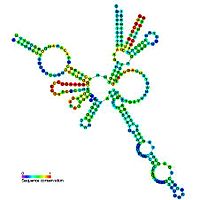
Photo from wikipedia
Purpose This study aimed to explore the role of the long non-coding RNA (lncRNA) RNA component of mitochondrial RNAase P (RMRP) in sepsis-induced acute kidney injury (AKI). Materials and Methods… Click to show full abstract
Purpose This study aimed to explore the role of the long non-coding RNA (lncRNA) RNA component of mitochondrial RNAase P (RMRP) in sepsis-induced acute kidney injury (AKI). Materials and Methods Venous blood was collected from septic patients and healthy people. C57BL/6 mice who underwent cecal ligation and puncture (CLP) were used as in vivo models of septic AKI. Lipopolysaccharide (LPS)-induced HK-2 cells were employed as in vitro models of AKI. Flow cytometry analysis was conducted to detect cell apoptosis. Enzyme-linked immunosorbent assay and Western blot assays were used to detect levels of pro-inflammatory cytokines. Results RMRP was upregulated in sera from patients with AKI and in LPS-induced cells. Knockdown of RMRP inhibited cell apoptosis and reduced production of inflammatory factors in LPS-induced cells, as well as alleviated AKI in CLP mice. RMRP facilitated inflammation by activating NACHT, LRR, and PYD domains-containing protein 3 (NLRP3) inflammasome. We found that microRNA 206 (miR-206) binds with and is negatively regulated by RMRP: miR-206 directly targets the 3′ untranslated region of DEAD-box helicase 5 (DDX5) and negatively regulates DDX5 expression. By binding with miR-206, RMRP upregulated DDX5 expression. Rescue assays revealed that overexpression of DDX5 counteracted the effect of RMRP inhibition on cell apoptosis and inflammatory response in LPS-induced cells. Conclusion The lncRNA RMRP contributes to sepsis-induced AKI through upregulation of DDX5 in a miR-206 dependent manner and through activation of NLRP3 inflammasome. This novel discovery may provide a potential strategy for treating AKI.
Journal Title: Yonsei Medical Journal
Year Published: 2021
Link to full text (if available)
Share on Social Media: Sign Up to like & get
recommendations!